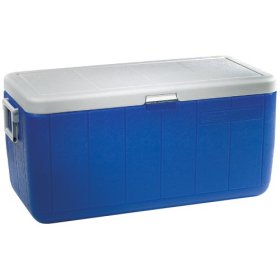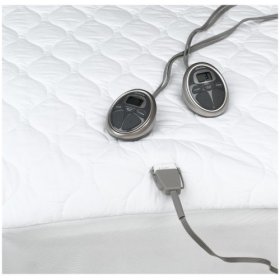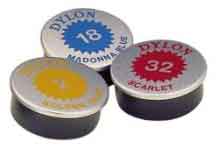will the cold prevent the dyes working?
Name: Helen Conway (downthewell.blogspot.com)
Message: I want to try hand dyeing a gradation of fabrics for quilting. I think that Cold water Dylon is the easiest for me to get hold of here in the UK. However, I am concerned about temperature. I have a tiny kitchen and will have to do it all out in the garage over the Christmas period which in the UK translates to just above freezing temperatures. I can wear layers but will the cold prevent the dyes working?

Yes, it will. It's good that you're thinking about this in advance. Dylon Cold Water Dye is a fiber reactive dye that does not require nearly as much warmth as, say, an all-purpose dye (which should be boiled with the fabric), but it does require some. Most of the colors in Dylon Cold Water Dye are Procion MX dyes, though a few are Drimarene K or Remazol type dyes. (See the post, "more about Dylon Cold Water Dyes ", in the Dye Forum on my site). The minimum temperature requirement is roughly 21°C (70°F), for dyes left to react with fabric overnight or longer; warmer temperatures work fine, too, and reduce the required amount of time. The reaction between fiber reactive dye and fabric can take place only in the presence of moisture, a high-pH chemical such as soda ash (also known as "Dylon Cold Fix"), and adequate warmth.
There are many different ways to heat up your dye reactions. If you're doing direct dye application, the simplest is to wrap them up so that you can safely take them into a warmer part of the house overnight. You can wrap each piece with plastic wrap, to prevent one part of the fabric from touching another when you roll it up, and then place the whole roll into a plastic bag, and carry the wrapped bundles in plastic buckets or boxes.

If you are dyeing in small buckets, you can fill your sink, or a large insulated cooler, with very hot tap water, and rest your buckets in there. (Don't fill the cooler so full of water that the buckets float; they might tip over, which would be a disaster.) The insulated cooler is ideal because it will hold the heat for hours. If you are dyeing in plastic bags, you can place several in each of a number of plastic buckets or bowls to heat in the same way. Alternatively, you can double-bag them in the sturdier zipper-top plastic bags used for freezer storage, and float those in the warm or hot water.

If you're working on a table, you can place an electric heating blanket or waterproof heated mattress pad (preferably one plugged into a ground fault circuit interrupter!) on the table, then cover that with a sturdy plastic sheet or tablecloth, and lay out your work on top of that, or do the reverse, laying your work out on the table, covering that with a reliable layer of sturdy thin plastic, with the electric blanket on top of that.
Avoid Dylon® Multi Purpose dye. Like Rit® dye and Tintex® Easy Fabric Dye, it is an all-purpose
dye which does not produce very long-lasting results on cotton, and it
requires high heat (87°C) to attach as well as possible to the fabric.
Dylon Cold Dye, Dylon Machine Dye, and Dylon Permanent dye (the latter available
in North America) all perform much better, since they are fiber reactive
dyes.
dye. Like Rit® dye and Tintex® Easy Fabric Dye, it is an all-purpose
dye which does not produce very long-lasting results on cotton, and it
requires high heat (87°C) to attach as well as possible to the fabric.
Dylon Cold Dye, Dylon Machine Dye, and Dylon Permanent dye (the latter available
in North America) all perform much better, since they are fiber reactive
dyes.
Dylon Cold Water dyes bond well to cotton fabric, since they are mostly Procion MX dyes, but they can be frustrating to work with, since the pure unmixed Procion MX dyes are not supplied in this line, but only mixtures of dye colors, designed to meet current fashion standards. There are no ideal primary colors in the Dylon Cold Dye line for mixing your own colors, because all have had some other color of dye added, which will cause your mixtures to be duller in color. Also, the tiny 5-gram tins are really very expensive, considering how little they will dye, only about 200 grams of fabric per tin, and only 100 grams for black. You will have to buy a great many of them if you are planning on doing much dyeing.
There are better dyes that you can buy, instead of Dylon dyes, if
you are going to be mixing your colors or doing color gradations. In the UK,
there are several good sources for buying fiber reactive dye by mail-order. See
my page of Sources
for Dyeing Supplies Around the World, scrolling down to the
section on Europe. For example, Fibrecrafts/George Weil sells Procion MX dyes
for £8.40 for 50 grams of dye, equivalent to at least ten of the tiny tins
of Dylon Cold, which each cost about £1.89. (It may be a better value
still, since the Dylon dye powders are likely to be more dilute than the Procion
MX dye powders sold by Fibrecrafts.) Fibrecrafts sells a good range of the pure unmixed
single-hue Procion MX dyes, which many dyers find to be much more
satisfying for use in color mixing and color gradations. I recommend that, at
minimum, you purchase lemon yellow, vibrant magenta or brilliant pink, brilliant
turquoise, and black; I recommend also that you get some golden yellow and
indigo navy. Also consider the other good mail-order suppliers listed on my page
of Sources
for Dyeing Supplies Around the World. You can buy soda ash
locally or from your mail-order dye supplier for much less money than Dylon Cold
Fix, as well, although they are identical substances.
if
you are going to be mixing your colors or doing color gradations. In the UK,
there are several good sources for buying fiber reactive dye by mail-order. See
my page of Sources
for Dyeing Supplies Around the World, scrolling down to the
section on Europe. For example, Fibrecrafts/George Weil sells Procion MX dyes
for £8.40 for 50 grams of dye, equivalent to at least ten of the tiny tins
of Dylon Cold, which each cost about £1.89. (It may be a better value
still, since the Dylon dye powders are likely to be more dilute than the Procion
MX dye powders sold by Fibrecrafts.) Fibrecrafts sells a good range of the pure unmixed
single-hue Procion MX dyes, which many dyers find to be much more
satisfying for use in color mixing and color gradations. I recommend that, at
minimum, you purchase lemon yellow, vibrant magenta or brilliant pink, brilliant
turquoise, and black; I recommend also that you get some golden yellow and
indigo navy. Also consider the other good mail-order suppliers listed on my page
of Sources
for Dyeing Supplies Around the World. You can buy soda ash
locally or from your mail-order dye supplier for much less money than Dylon Cold
Fix, as well, although they are identical substances.
(Please help support this web site. Thank you.)
Message: I want to try hand dyeing a gradation of fabrics for quilting. I think that Cold water Dylon is the easiest for me to get hold of here in the UK. However, I am concerned about temperature. I have a tiny kitchen and will have to do it all out in the garage over the Christmas period which in the UK translates to just above freezing temperatures. I can wear layers but will the cold prevent the dyes working?

Yes, it will. It's good that you're thinking about this in advance. Dylon Cold Water Dye is a fiber reactive dye that does not require nearly as much warmth as, say, an all-purpose dye (which should be boiled with the fabric), but it does require some. Most of the colors in Dylon Cold Water Dye are Procion MX dyes, though a few are Drimarene K or Remazol type dyes. (See the post, "more about Dylon Cold Water Dyes ", in the Dye Forum on my site). The minimum temperature requirement is roughly 21°C (70°F), for dyes left to react with fabric overnight or longer; warmer temperatures work fine, too, and reduce the required amount of time. The reaction between fiber reactive dye and fabric can take place only in the presence of moisture, a high-pH chemical such as soda ash (also known as "Dylon Cold Fix"), and adequate warmth.
There are many different ways to heat up your dye reactions. If you're doing direct dye application, the simplest is to wrap them up so that you can safely take them into a warmer part of the house overnight. You can wrap each piece with plastic wrap, to prevent one part of the fabric from touching another when you roll it up, and then place the whole roll into a plastic bag, and carry the wrapped bundles in plastic buckets or boxes.

If you are dyeing in small buckets, you can fill your sink, or a large insulated cooler, with very hot tap water, and rest your buckets in there. (Don't fill the cooler so full of water that the buckets float; they might tip over, which would be a disaster.) The insulated cooler is ideal because it will hold the heat for hours. If you are dyeing in plastic bags, you can place several in each of a number of plastic buckets or bowls to heat in the same way. Alternatively, you can double-bag them in the sturdier zipper-top plastic bags used for freezer storage, and float those in the warm or hot water.

If you're working on a table, you can place an electric heating blanket or waterproof heated mattress pad (preferably one plugged into a ground fault circuit interrupter!) on the table, then cover that with a sturdy plastic sheet or tablecloth, and lay out your work on top of that, or do the reverse, laying your work out on the table, covering that with a reliable layer of sturdy thin plastic, with the electric blanket on top of that.
Avoid Dylon® Multi Purpose
 dye. Like Rit® dye and Tintex® Easy Fabric Dye, it is an all-purpose
dye which does not produce very long-lasting results on cotton, and it
requires high heat (87°C) to attach as well as possible to the fabric.
Dylon Cold Dye, Dylon Machine Dye, and Dylon Permanent dye (the latter available
in North America) all perform much better, since they are fiber reactive
dyes.
dye. Like Rit® dye and Tintex® Easy Fabric Dye, it is an all-purpose
dye which does not produce very long-lasting results on cotton, and it
requires high heat (87°C) to attach as well as possible to the fabric.
Dylon Cold Dye, Dylon Machine Dye, and Dylon Permanent dye (the latter available
in North America) all perform much better, since they are fiber reactive
dyes.Dylon Cold Water dyes bond well to cotton fabric, since they are mostly Procion MX dyes, but they can be frustrating to work with, since the pure unmixed Procion MX dyes are not supplied in this line, but only mixtures of dye colors, designed to meet current fashion standards. There are no ideal primary colors in the Dylon Cold Dye line for mixing your own colors, because all have had some other color of dye added, which will cause your mixtures to be duller in color. Also, the tiny 5-gram tins are really very expensive, considering how little they will dye, only about 200 grams of fabric per tin, and only 100 grams for black. You will have to buy a great many of them if you are planning on doing much dyeing.
There are better dyes that you can buy, instead of Dylon dyes,
 if
you are going to be mixing your colors or doing color gradations. In the UK,
there are several good sources for buying fiber reactive dye by mail-order. See
my page of Sources
for Dyeing Supplies Around the World, scrolling down to the
section on Europe. For example, Fibrecrafts/George Weil sells Procion MX dyes
for £8.40 for 50 grams of dye, equivalent to at least ten of the tiny tins
of Dylon Cold, which each cost about £1.89. (It may be a better value
still, since the Dylon dye powders are likely to be more dilute than the Procion
MX dye powders sold by Fibrecrafts.) Fibrecrafts sells a good range of the pure unmixed
single-hue Procion MX dyes, which many dyers find to be much more
satisfying for use in color mixing and color gradations. I recommend that, at
minimum, you purchase lemon yellow, vibrant magenta or brilliant pink, brilliant
turquoise, and black; I recommend also that you get some golden yellow and
indigo navy. Also consider the other good mail-order suppliers listed on my page
of Sources
for Dyeing Supplies Around the World. You can buy soda ash
locally or from your mail-order dye supplier for much less money than Dylon Cold
Fix, as well, although they are identical substances.
if
you are going to be mixing your colors or doing color gradations. In the UK,
there are several good sources for buying fiber reactive dye by mail-order. See
my page of Sources
for Dyeing Supplies Around the World, scrolling down to the
section on Europe. For example, Fibrecrafts/George Weil sells Procion MX dyes
for £8.40 for 50 grams of dye, equivalent to at least ten of the tiny tins
of Dylon Cold, which each cost about £1.89. (It may be a better value
still, since the Dylon dye powders are likely to be more dilute than the Procion
MX dye powders sold by Fibrecrafts.) Fibrecrafts sells a good range of the pure unmixed
single-hue Procion MX dyes, which many dyers find to be much more
satisfying for use in color mixing and color gradations. I recommend that, at
minimum, you purchase lemon yellow, vibrant magenta or brilliant pink, brilliant
turquoise, and black; I recommend also that you get some golden yellow and
indigo navy. Also consider the other good mail-order suppliers listed on my page
of Sources
for Dyeing Supplies Around the World. You can buy soda ash
locally or from your mail-order dye supplier for much less money than Dylon Cold
Fix, as well, although they are identical substances.(Please help support this web site. Thank you.)
Posted: Monday - November 26, 2007 at 09:40 AM
Follow this blog on twitter here.
Quick Links
- All About Dyes & Dyeing Top -
- Top of this blog -
- FAQ -
- The Dye Forum -
- How to Tie Dye - How to Batik -
- Books - Toys - Plants -
- Top of this blog -
- FAQ -
- The Dye Forum -
- How to Tie Dye - How to Batik -
- Books - Toys - Plants -
More in this category:
- -
Statistics
Total entries in this blog:
Total entries in this category:
Published On: Aug 29, 2012 02:48 PM
Total entries in this category:
Published On: Aug 29, 2012 02:48 PM